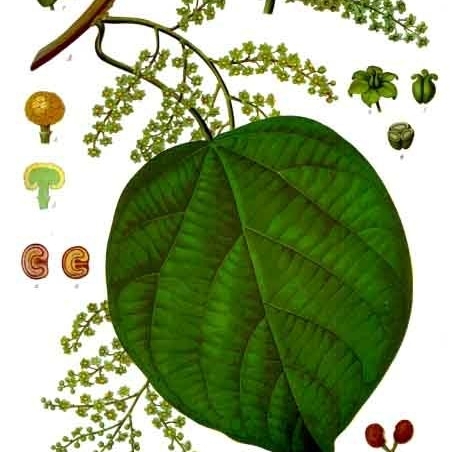Young stems and petioles usually drying pale greyish straw-coloured, striate, glabrous. Leaves with glabrous petioles 6—18(—26) cm, swollen at both ends, geniculate at the base; lamina ovate to broadly ovate, base cordate to truncate (or broadly obtuse), apex usually acuminate, 16-28 by 10-24 cm, palmately 3-5(-7)-nerved at base and with 4-5 pairs of lateral nerves running ± parallel with the main, i.e. distal, pair of basal nerves, the lateral nerves linked together with scalariform veins; lower surface with reticulum clearly visible and slightly raised, drying pale straw-coloured against a pale grey-brown background, midrib and nerves very prominent; upper surface drying slightly darker, subnitidous, midrib prominent; glabrous on both surfaces apart from pockets of hairs in the axils of the nerves and main veins, thinly coriaceous. Inflorescences 16-40 cm with lateral branches 2-5 cm, glabrous, bracteoles c. 0.5 mm long. Male flowers with glabrous pedicels becoming up to 2-3 mm; sepals white, yellow or pale green, outer sepals 2, scarcely 1 mm long, inner sepals 6, broadly elliptic, 2.5-3 by 2 mm, glabrous, apart from often minutely papillose margin; synandrium 1.5-2 mm long. Female flowers: pedicels and sepals as in male; staminodes 6, minute, scarcely 0.25 mm; carpels 3(-4), curved-ellipsoidal, 1.5-2 mm; stigma thick, recurved. Infructescences wholly glabrous, lateral branches up to 15 cm; carpophore (3—)6—16 mm, continuous with pedicel 8-20 mm. Drupes white, 9-11 mm long, glabrous; endocarp subreniform-globose, surface reticulate-rugulose with a weak dorsal groove; cotyledons ± narrowly elliptic 5-7 mm long, 2 mm broad.
More
A strong climbing shrub. It can be 15-25 m tall. The stem can be 10 cm across. They twine to the left. The leaves are broadly oval and the leaf stalk can be 6-26 cm long. The flowers are small, yellowish-white and have a sweet scent. The fruit is a fleshy berry. They can be white, red or dark purple. The seeds are deeply cup shaped.
Lowland, in a variety of conditions, on banks of rivers and streams, coastal forest, savannahs, on basalt, limestone and sandy soil, both in rain-forest conditions and in seasonal climates, but judging from the scanty occurrence in Java and Sumatra and absence in Malaya and Borneo, with a distinct preference for seasonal conditions, it accounts for the high frequency in the Lesser Sunda Is.
More
A tropical plant. It grows on the edges of forests and on riverbanks, It can be on limestone or sandy soils. It grows up to 400 m above sea level. It occurs in the Western Ghats in India.
Occurs naturally in forest and forest fringes, in thickets, on river banks, near streams, in savannah, at elevations up to 400 metres.
Uses. The stem produces bast-fibres. The fruits are used as a fish-poison and are also used to kill lice in the hair. They are a source of picrotoxin, which has proved to be a mixed crystallizate of picrotoxinin, which is a violent convulsant poison, and picrotin, which is very much less toxic. Picrotoxin has been used in the treatment of schizophrenia and is an effective antidote for barbiturate and morphine poisoning. A review of the chemical constituents and pharmacological properties is given by QUISUMBING ( QUISUMBING Medic. Pl. Philip. 1951 290 1030 ) and in Wealth of India, Raw Materials 1 1948 75 .According to FLÜCKIGER & HANBURY ( FLÜCKIGER & HANBURY Pharmacographia ed. 2 1879 31-33 ) the fruits have been known in Europe at least since the 16th century when they were being imported via Alexandria and other centres in the Middle East. They are well figured in GERARDE'S Herbal of 1597. In the 1633 edition, p. 1548 he stated that they were 'well known in shoppes by the name of Cocculus Indicus, some call them Cocci Orientales. They are used with good success to kill lice in children's heads. In England we use the fruit called Cocculus Indi in pouder mixed with flower, hony, and crummes of bread to catch fish with, it being a numming, soporiferous, or sleeping medicine, causeth the fish to turn up their bellies, as being senceless for a time.' In 1635 the fruits were subject in England to an import duty of 2s. per pound. HOOKERf. & THOMSON (1855) reported of the fruits that 'in England they are extensively used in the adulteration of beer.'.
More
Fruit were used as an adulteration in beer. CAUTION: They are poisonous.

